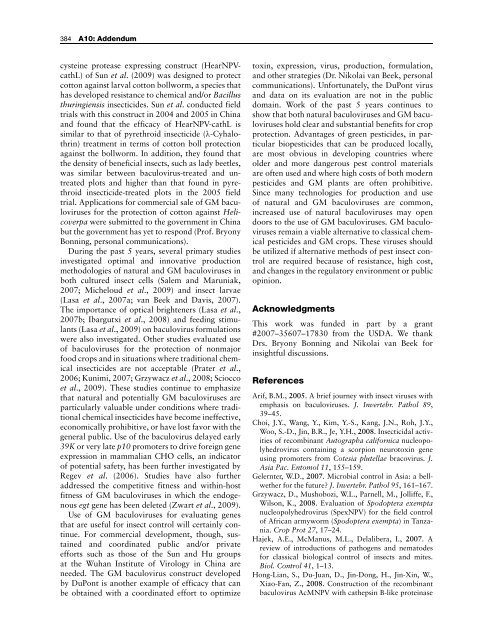Insect Control: Biological and Synthetic Agents - Index of
Insect Control: Biological and Synthetic Agents - Index of
Insect Control: Biological and Synthetic Agents - Index of
Create successful ePaper yourself
Turn your PDF publications into a flip-book with our unique Google optimized e-Paper software.
384 A10: Addendum<br />
cysteine protease expressing construct (HearNPVcathL)<br />
<strong>of</strong> Sun et al. (2009) was designed to protect<br />
cotton against larval cotton bollworm, a species that<br />
has developed resistance to chemical <strong>and</strong>/or Bacillus<br />
thuringiensis insecticides. Sun et al. conducted field<br />
trials with this construct in 2004 <strong>and</strong> 2005 in China<br />
<strong>and</strong> found that the efficacy <strong>of</strong> HearNPV-cathL is<br />
similar to that <strong>of</strong> pyrethroid insecticide (l-Cyhalothrin)<br />
treatment in terms <strong>of</strong> cotton boll protection<br />
against the bollworm. In addition, they found that<br />
the density <strong>of</strong> beneficial insects, such as lady beetles,<br />
was similar between baculovirus-treated <strong>and</strong> untreated<br />
plots <strong>and</strong> higher than that found in pyrethroid<br />
insecticide-treated plots in the 2005 field<br />
trial. Applications for commercial sale <strong>of</strong> GM baculoviruses<br />
for the protection <strong>of</strong> cotton against Helicoverpa<br />
were submitted to the government in China<br />
but the government has yet to respond (Pr<strong>of</strong>. Bryony<br />
Bonning, personal communications).<br />
During the past 5 years, several primary studies<br />
investigated optimal <strong>and</strong> innovative production<br />
methodologies <strong>of</strong> natural <strong>and</strong> GM baculoviruses in<br />
both cultured insect cells (Salem <strong>and</strong> Maruniak,<br />
2007; Micheloud et al., 2009) <strong>and</strong> insect larvae<br />
(Lasa et al., 2007a; van Beek <strong>and</strong> Davis, 2007).<br />
The importance <strong>of</strong> optical brighteners (Lasa et al.,<br />
2007b; Ibargutxi et al., 2008) <strong>and</strong> feeding stimulants<br />
(Lasa et al., 2009) on baculovirus formulations<br />
were also investigated. Other studies evaluated use<br />
<strong>of</strong> baculoviruses for the protection <strong>of</strong> nonmajor<br />
food crops <strong>and</strong> in situations where traditional chemical<br />
insecticides are not acceptable (Prater et al.,<br />
2006; Kunimi, 2007; Grzywacz et al., 2008; Sciocco<br />
et al., 2009). These studies continue to emphasize<br />
that natural <strong>and</strong> potentially GM baculoviruses are<br />
particularly valuable under conditions where traditional<br />
chemical insecticides have become ineffective,<br />
economically prohibitive, or have lost favor with the<br />
general public. Use <strong>of</strong> the baculovirus delayed early<br />
39K or very late p10 promoters to drive foreign gene<br />
expression in mammalian CHO cells, an indicator<br />
<strong>of</strong> potential safety, has been further investigated by<br />
Regev et al. (2006). Studies have also further<br />
addressed the competitive fitness <strong>and</strong> within-host<br />
fitness <strong>of</strong> GM baculoviruses in which the endogenous<br />
egt gene has been deleted (Zwart et al., 2009).<br />
Use <strong>of</strong> GM baculoviruses for evaluating genes<br />
that are useful for insect control will certainly continue.<br />
For commercial development, though, sustained<br />
<strong>and</strong> coordinated public <strong>and</strong>/or private<br />
efforts such as those <strong>of</strong> the Sun <strong>and</strong> Hu groups<br />
at the Wuhan Institute <strong>of</strong> Virology in China are<br />
needed. The GM baculovirus construct developed<br />
by DuPont is another example <strong>of</strong> efficacy that can<br />
be obtained with a coordinated effort to optimize<br />
toxin, expression, virus, production, formulation,<br />
<strong>and</strong> other strategies (Dr. Nikolai van Beek, personal<br />
communications). Unfortunately, the DuPont virus<br />
<strong>and</strong> data on its evaluation are not in the public<br />
domain. Work <strong>of</strong> the past 5 years continues to<br />
show that both natural baculoviruses <strong>and</strong> GM baculoviruses<br />
hold clear <strong>and</strong> substantial benefits for crop<br />
protection. Advantages <strong>of</strong> green pesticides, in particular<br />
biopesticides that can be produced locally,<br />
are most obvious in developing countries where<br />
older <strong>and</strong> more dangerous pest control materials<br />
are <strong>of</strong>ten used <strong>and</strong> where high costs <strong>of</strong> both modern<br />
pesticides <strong>and</strong> GM plants are <strong>of</strong>ten prohibitive.<br />
Since many technologies for production <strong>and</strong> use<br />
<strong>of</strong> natural <strong>and</strong> GM baculoviruses are common,<br />
increased use <strong>of</strong> natural baculoviruses may open<br />
doors to the use <strong>of</strong> GM baculoviruses. GM baculoviruses<br />
remain a viable alternative to classical chemical<br />
pesticides <strong>and</strong> GM crops. These viruses should<br />
be utilized if alternative methods <strong>of</strong> pest insect control<br />
are required because <strong>of</strong> resistance, high cost,<br />
<strong>and</strong> changes in the regulatory environment or public<br />
opinion.<br />
Acknowledgments<br />
This work was funded in part by a grant<br />
#2007–35607–17830 from the USDA. We thank<br />
Drs. Bryony Bonning <strong>and</strong> Nikolai van Beek for<br />
insightful discussions.<br />
References<br />
Arif, B.M., 2005. A brief journey with insect viruses with<br />
emphasis on baculoviruses. J. Invertebr. Pathol 89,<br />
39–45.<br />
Choi, J.Y., Wang, Y., Kim, Y.-S., Kang, J.N., Roh, J.Y.,<br />
Woo, S.-D., Jin, B.R., Je, Y.H., 2008. <strong>Insect</strong>icidal activities<br />
<strong>of</strong> recombinant Autographa californica nucleopolyhedrovirus<br />
containing a scorpion neurotoxin gene<br />
using promoters from Cotesia plutellae bracovirus. J.<br />
Asia Pac. Entomol 11, 155–159.<br />
Gelernter, W.D., 2007. Microbial control in Asia: a bellwether<br />
for the future? J. Invertebr. Pathol 95, 161–167.<br />
Grzywacz, D., Mushobozi, W.L., Parnell, M., Jolliffe, F.,<br />
Wilson, K., 2008. Evaluation <strong>of</strong> Spodoptera exempta<br />
nucleopolyhedrovirus (SpexNPV) for the field control<br />
<strong>of</strong> African armyworm (Spodoptera exempta) in Tanzania.<br />
Crop Prot 27, 17–24.<br />
Hajek, A.E., McManus, M.L., Delalibera, I., 2007. A<br />
review <strong>of</strong> introductions <strong>of</strong> pathogens <strong>and</strong> nematodes<br />
for classical biological control <strong>of</strong> insects <strong>and</strong> mites.<br />
Biol. <strong>Control</strong> 41, 1–13.<br />
Hong-Lian, S., Du-Juan, D., Jin-Dong, H., Jin-Xin, W.,<br />
Xiao-Fan, Z., 2008. Construction <strong>of</strong> the recombinant<br />
baculovirus AcMNPV with cathepsin B-like proteinase










